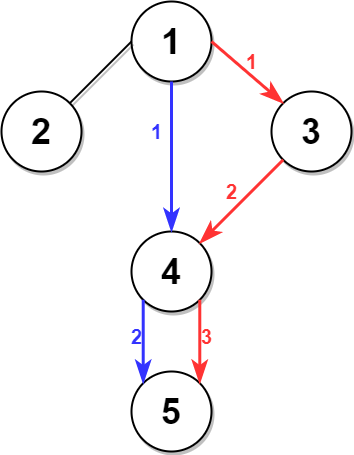Welcome to Subscribe On Youtube
Formatted question description: https://leetcode.ca/all/2045.html
2045. Second Minimum Time to Reach Destination (Hard)
A city is represented as a bi-directional connected graph with n vertices where each vertex is labeled from 1 to n (inclusive). The edges in the graph are represented as a 2D integer array edges, where each edges[i] = [ui, vi] denotes a bi-directional edge between vertex ui and vertex vi. Every vertex pair is connected by at most one edge, and no vertex has an edge to itself. The time taken to traverse any edge is time minutes.
Each vertex has a traffic signal which changes its color from green to red and vice versa every change minutes. All signals change at the same time. You can enter a vertex at any time, but can leave a vertex only when the signal is green. You cannot wait at a vertex if the signal is green.
The second minimum value is defined as the smallest value strictly larger than the minimum value.
- For example the second minimum value of
[2, 3, 4]is3, and the second minimum value of[2, 2, 4]is4.
Given n, edges, time, and change, return the second minimum time it will take to go from vertex 1 to vertex n.
Notes:
- You can go through any vertex any number of times, including
1andn. - You can assume that when the journey starts, all signals have just turned green.
Example 1:


Input: n = 5, edges = [[1,2],[1,3],[1,4],[3,4],[4,5]], time = 3, change = 5 Output: 13 Explanation: The figure on the left shows the given graph. The blue path in the figure on the right is the minimum time path. The time taken is: - Start at 1, time elapsed=0 - 1 -> 4: 3 minutes, time elapsed=3 - 4 -> 5: 3 minutes, time elapsed=6 Hence the minimum time needed is 6 minutes. The red path shows the path to get the second minimum time. - Start at 1, time elapsed=0 - 1 -> 3: 3 minutes, time elapsed=3 - 3 -> 4: 3 minutes, time elapsed=6 - Wait at 4 for 4 minutes, time elapsed=10 - 4 -> 5: 3 minutes, time elapsed=13 Hence the second minimum time is 13 minutes.
Example 2:

Input: n = 2, edges = [[1,2]], time = 3, change = 2 Output: 11 Explanation: The minimum time path is 1 -> 2 with time = 3 minutes. The second minimum time path is 1 -> 2 -> 1 -> 2 with time = 11 minutes.
Constraints:
2 <= n <= 104n - 1 <= edges.length <= min(2 * 104, n * (n - 1) / 2)edges[i].length == 21 <= ui, vi <= nui != vi- There are no duplicate edges.
- Each vertex can be reached directly or indirectly from every other vertex.
1 <= time, change <= 103
Similar Questions:
- Network Delay Time (Medium)
- Find the City With the Smallest Number of Neighbors at a Threshold Distance (Medium)
- Number of Ways to Arrive at Destination (Medium)
Solution 1. BFS
Intuition: If the shortest path from 1 to n is of length L, find whether there is a path of length L + 1 by taking a detour. There is always a path of length L + 2 (by going back-and-forth).
// OJ: https://leetcode.com/problems/second-minimum-time-to-reach-destination/
// Time: O(N + E)
// Space: O(N + E)
// Ref: https://leetcode.com/problems/second-minimum-time-to-reach-destination/discuss/1525165/C%2B%2B-Two-BFS-with-detailed-explanation
class Solution {
public:
int secondMinimum(int n, vector<vector<int>>& E, int time, int change) {
vector<vector<int>> G(n);
for (auto &e : E) {
int u = e[0] - 1, v = e[1] - 1;
G[u].push_back(v);
G[v].push_back(u);
}
vector<int> dist(n, INT_MAX);
dist[n - 1] = 0;
queue<int> q{ {n - 1} };
while (q.size()) {
int u = q.front();
q.pop();
for (int v : G[u]) {
if (dist[v] != INT_MAX) continue;
dist[v] = 1 + dist[u];
q.push(v);
}
}
int len = dist[0] + 2; // Try to find a path of length `dist[0] + 1`
q.push(0);
bool found = false;
while (q.size() && !found) {
int u = q.front();
q.pop();
for (int v : G[u]) {
if (dist[v] == dist[u]) { // u and v are at the same layer of the shortest path, so dist[u] can be 1 + dist[u] by going to v first then u.
len--;
found = true;
break;
} else if (dist[v] == dist[u] - 1) q.push(v); // push the nodes on the next layer of the shortest path
}
}
int ans = 0;
for (int i = 0; i < len; ++i) {
ans += time;
if (i != len - 1 && ans / change % 2) ans = (ans / change + 1) * change;
}
return ans;
}
};
Or
// OJ: https://leetcode.com/problems/second-minimum-time-to-reach-destination/
// Time: O(N + E)
// Space: O(N + E)
// Ref: https://leetcode.com/problems/second-minimum-time-to-reach-destination/discuss/1525154/No-Dijkstra%3A-(n-%2B-1)-or-(n-%2B-2)
class Solution {
public:
int secondMinimum(int n, vector<vector<int>>& E, int time, int change) {
auto getTime = [&](int step) {
int ans = 0;
for (int i = 0; i < step; ++i) {
ans += time;
if (i != step - 1 && ans / change % 2) ans = (ans / change + 1) * change;
}
return ans;
};
vector<vector<int>> G(n);
for (auto &e : E) {
int u = e[0] - 1, v = e[1] - 1;
G[u].push_back(v);
G[v].push_back(u);
}
vector<int> dist(n, 10001);
queue<int> q{ {0} };
int step = 0;
while (q.size() && step <= dist[n - 1] + 1) {
int cnt = q.size();
while (cnt--) {
int u = q.front();
q.pop();
if (step == dist[u] || step > dist[u] + 1) continue; // Only visit node `u` if it haven't been visited or this visit takes only one more step than last time.
dist[u] = min(dist[u], step);
if (u == n - 1 && step == dist[n - 1] + 1) return getTime(step);
for (int v : G[u]) q.push(v);
}
++step;
}
return getTime(dist[n - 1] + 2);
}
};